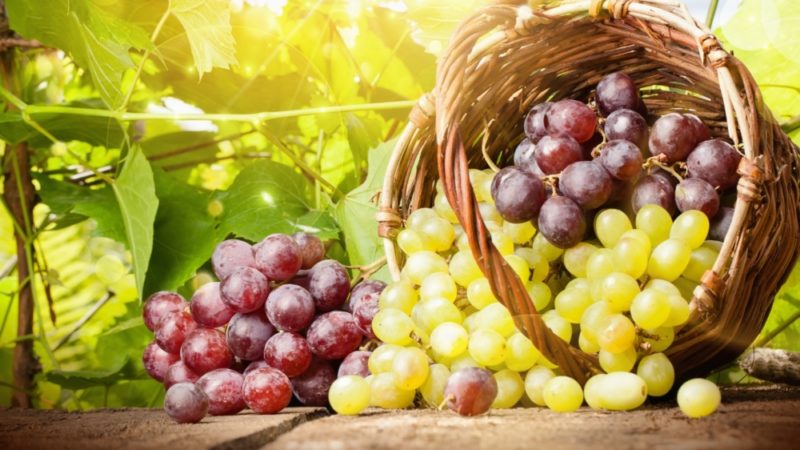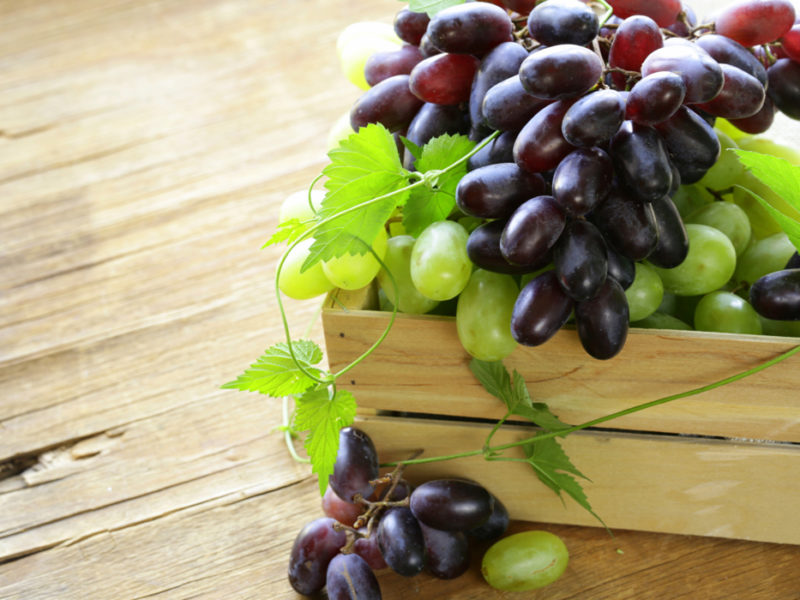Not everyone knows that you can lose extra pounds by spoiling yourself with delicious sweet berries. To do this, it is enough to study how many calories are in grapes in order to quite successfully put into practice a “tasty” diet.
Material Content:
Chemical composition and nutritional value of the product
The composition of berries contains such components:
- proteins
- fats, in particular lipid compounds;
- carbohydrates, including sugar;
- cellulose;
- pectins;
- enzyme substances;
- trace elements: zinc, iron, calcium, phosphorus, magnesium, other elements;
- organic acids, mainly tartaric and malic;
- vitamins A, E, K, PP, C, B1, B2, B3, B6, B9, B12 and others.
The main share in the chemical composition of fruits is water in the form of grape juice. The fluid contains a significant amount of fructose and glucose. In the human body, these monosaccharides are easily processed and converted into energy. 100 g of grapes contains an average of 55 to 70 kcal. The nutritional value of sweet berries depends on the variety, the characteristics of the cultivation, transportation and storage of fruits.
How many calories in grapes of different varieties
The calorie content of grapes is not affected by its varied color. A significant role in determining nutritional value is varietal affiliation.
The approximate calorie content in 100 g of various grapes:
| Technical grades: | |
|---|---|
| Riesling | 42–44 kcal |
| Rkatsiteli, Chardonnay | 55–65 kcal |
| Muscat, Aligote | 63–66 kcal |
| Lydia | 75 kcal |
| Dining rooms: | |
|---|---|
| Typhi | 65 kcal |
| Cardinal | 65 kcal |
| Lady fingers | 70 kcal |
| Kishmish | 65–95 kcal |
The average calorie content of black grapes is 65–75 kcal, green is about 70 kcal, red is 65 kcal, and white contains 65 kcal per 100 g of product.
Sweet clusters are used not only in fresh form:
- Using various presses, grape juice is produced from berries. Its nutritional value is about 55–70 kcal per 100 g of liquid.
- Wine is made on the basis of fermented juice. The calorie content of such an alcoholic beverage depends on the grape variety that is used in this case, as well as the method of production. On average, 100 g of liquid has about 80 kcal if sugar is not added to it.
- The fruits are dried. In grapes raisins and cinnamon there are no seeds, therefore raisins are most often made from berries of these varieties. Such products are added to the dough when baking sweet muffin. And also use varieties of Husayn to get large and meaty raisins for cooking compotes. After drying, the grape retains almost all of its beneficial properties. It is not only used in various culinary recipes. This is a great snack that will quickly satisfy your hunger, because the nutritional value of raisins is much greater than that of fresh produce. On average, 100 g of dried fruit contains 265 calories.
Useful properties of berries
To include grapes in the menu is advisable for many reasons.
Delicious fruits will help:
- to improve the general condition;
- to stabilize pressure;
- overcome iron deficiency anemia (red varieties);
- increase the acidity of the stomach with reduced enzyme activity;
- cope with respiratory diseases;
- restore performance after stress, past illnesses, physical exertion;
- cleanse the liver and kidneys of toxic substances;
- reduce the risk of cancer;
- have a diuretic effect;
- activate metabolic processes;
- get rid of constipation;
- slow down the aging of the body;
- prevent the development of osteoporosis;
- to regulate digestion, to establish the work of beneficial bacteria in the intestine.
A significant part of the valuable substances is in the skin of berries, therefore it is worth consuming the whole dessert. The use of grape juice will also benefit. It is enough to drink a glass of drink to get a daily dose of B vitamins. Light varieties of sweet liquid invigorate and increase immunity, and dark ones are an excellent prophylactic against breast cancer and age-related vision loss. Grape juice will help to cope with migraines and increase efficiency.
There are a number of restrictions that are considered when eating berries:
- In the children's menu, the product is included gradually, not earlier than 2-3 years of age.
- Even in the absence of disease, it is advisable to eat up to 0.5 kg of goodies per day. To consume more than 2.5 kg of product per day is dangerous to health.
- Dark varieties have more antioxidants, but they often cause allergic reactions.
- Grape juice spoils tooth enamel, and therefore, after drinking, rinse your mouth with ordinary drinking water.
- Dessert in combination with dairy products, alcoholic beverages, fatty foods and raw vegetables is undesirable - this can cause diarrhea.
In case of heart disease, one should enjoy delicious berries with caution. Diabetes mellitus, peptic ulcer disease and some other health problems are a serious reason to abandon the fruit.
Can I eat with weight loss
Grapes are a fairly high-calorie product. But it is quite appropriate to include it in the diet in order to lose a few extra pounds. Losing weight with the help of aromatic fruits is possible only after consultation with a specialist, especially in the presence of chronic diseases. The harvest season is the right time for such a diet.
What should be paid attention to those who decided to lose weight with the help of grapes:
- Such a mono-diet can provoke the development of peptic ulcer and other gastrointestinal problems, and cause headaches.
- You can not use it for people with significantly overweight, pregnant and lactating women, as well as with a tendency to swelling.
- A few days before the course, fatty, sweet and fried foods, salinity, alcohol, and dairy products are removed from the menu.
- It is advisable to opt for a product with a thin skin. And also alternate dark and light varieties, because their composition is different.
- It is unacceptable to eat unripe grapes. It is better to choose not very sweet, low-calorie varieties.
- Berries are washed well before use. Eat slowly, with seeds and peel. Chew each grape thoroughly.
- Exit from the diet is carried out gradually. The first days after its completion, heavy and fatty foods are excluded from food.
You can organize a strict mono-diet on one grape. Many hesitate to take radical measures. When there is no desire or opportunity to completely remove other food from the diet, it is recommended to use a more gentle option. To do this, additional food items should be added to the menu, the main thing is that they are low in calories.
The most common grape diets:
- Three day unloading marathon. Use only grapes. During the first day - 500 grams of berries, the second - up to 1.5 kg, the third - up to 2 kg. The daily dose is divided into 5-6 meals. Be sure to drink plenty of fluids, preferably plain water or unsweetened herbal tea. Have dinner no later than 3 hours before bedtime.
- Comprehensive seven-day meal. Daily consume 1 kg of berries. Additionally include lean meats (up to 250 g per day). Vegetables, rice and buckwheat in small quantities are also introduced into the diet. The drink is plentiful: water, rosehip infusions, rosemary.
With a weekly grape diet, a slight deterioration in general condition is sometimes observed. A similar manifestation is observed about 3 days from the start of the course. Typically, this symptom indicates that the body is cleansed of toxins and toxins. If the well-being does not normalize after 1–2 days, the diet is stopped and consult a doctor.
Grapes can be beneficial if consumed correctly. In this case, they will certainly help to lose weight, improve health and improve mood.















